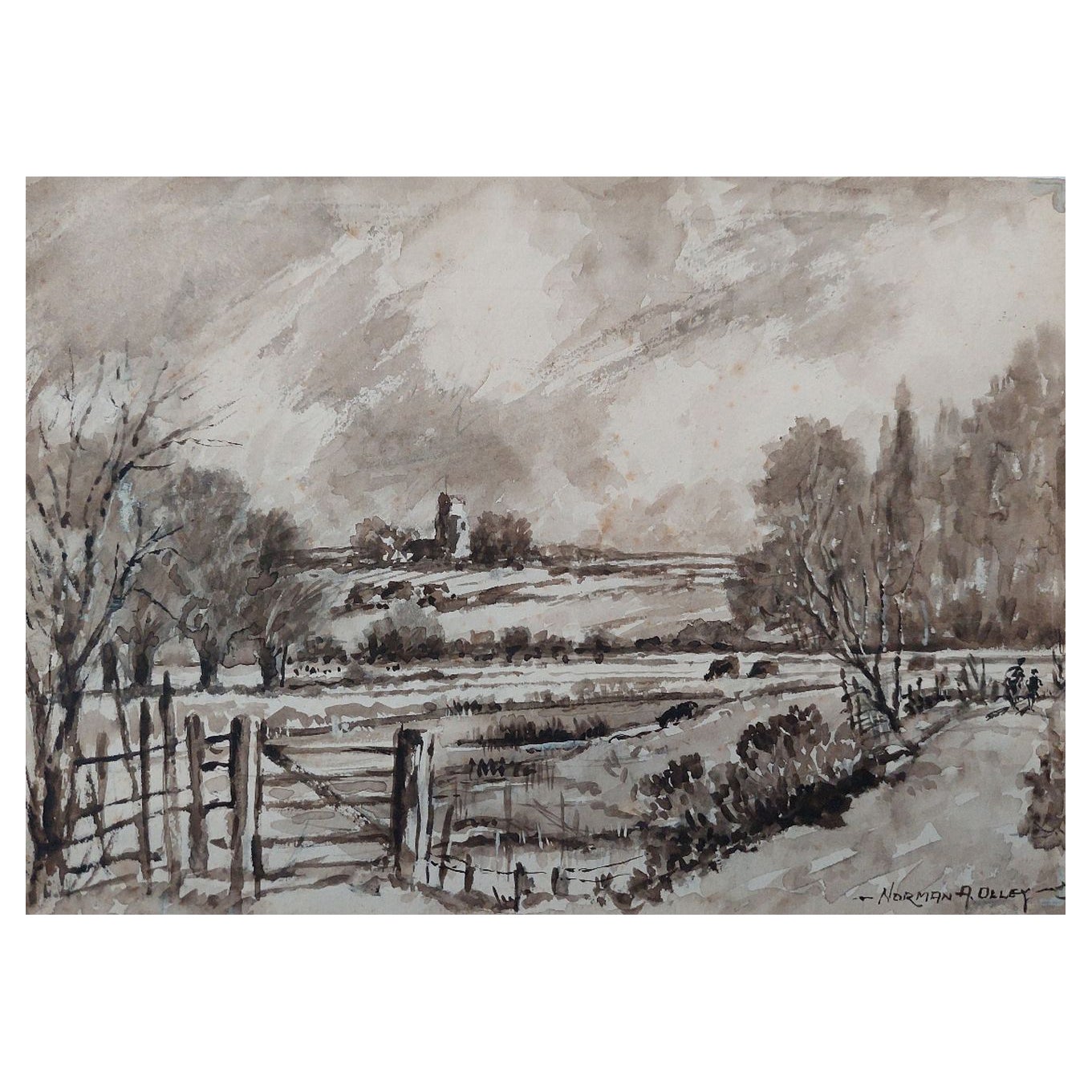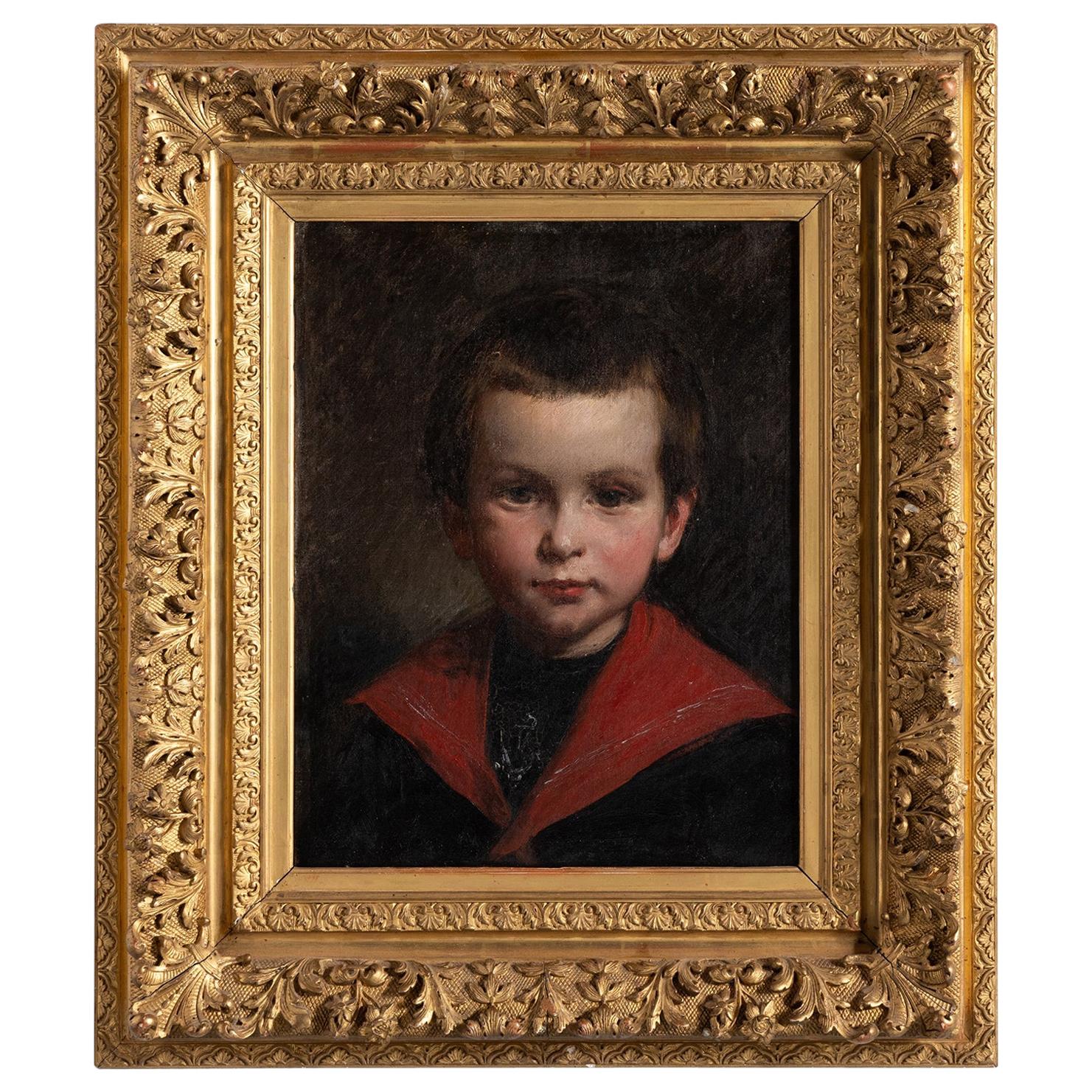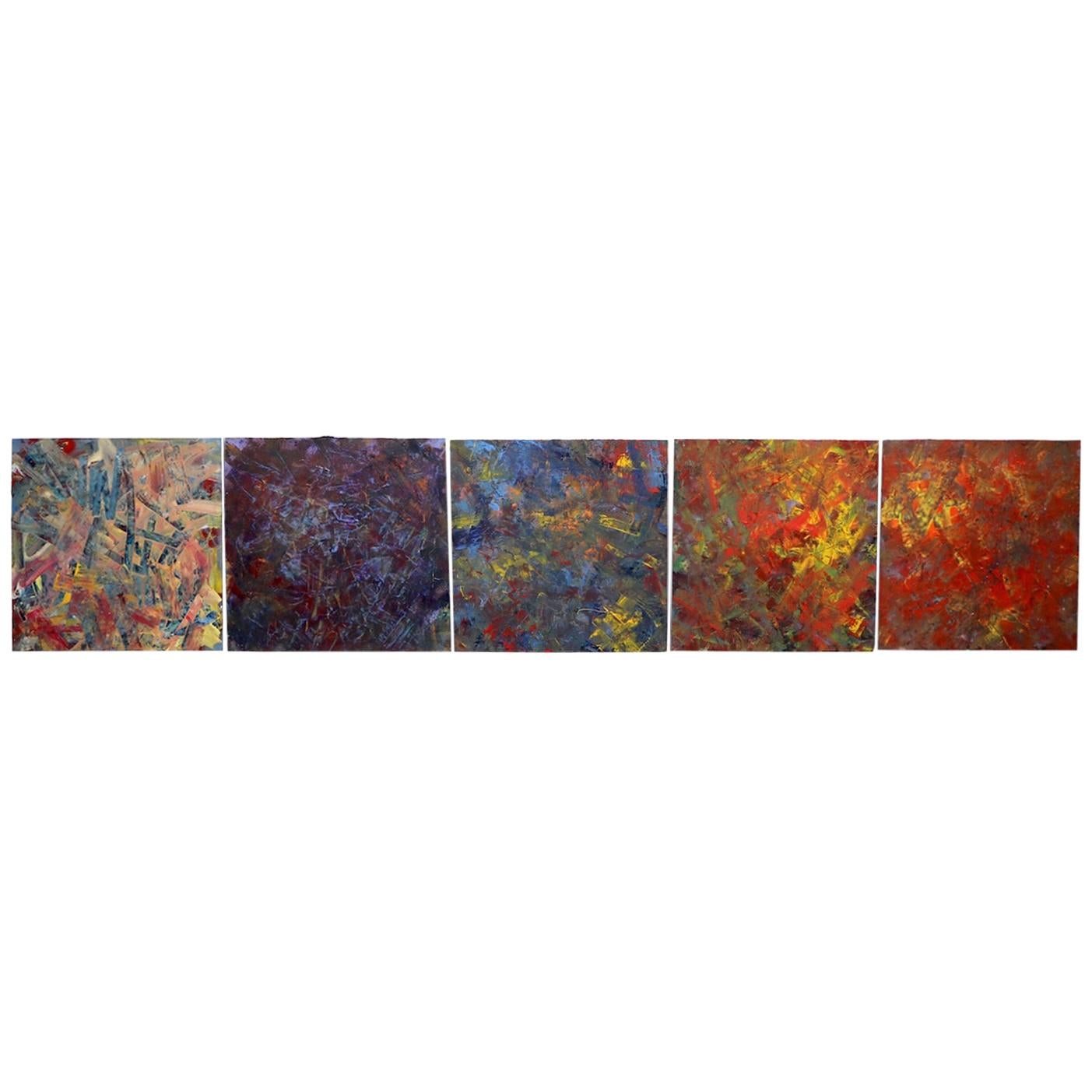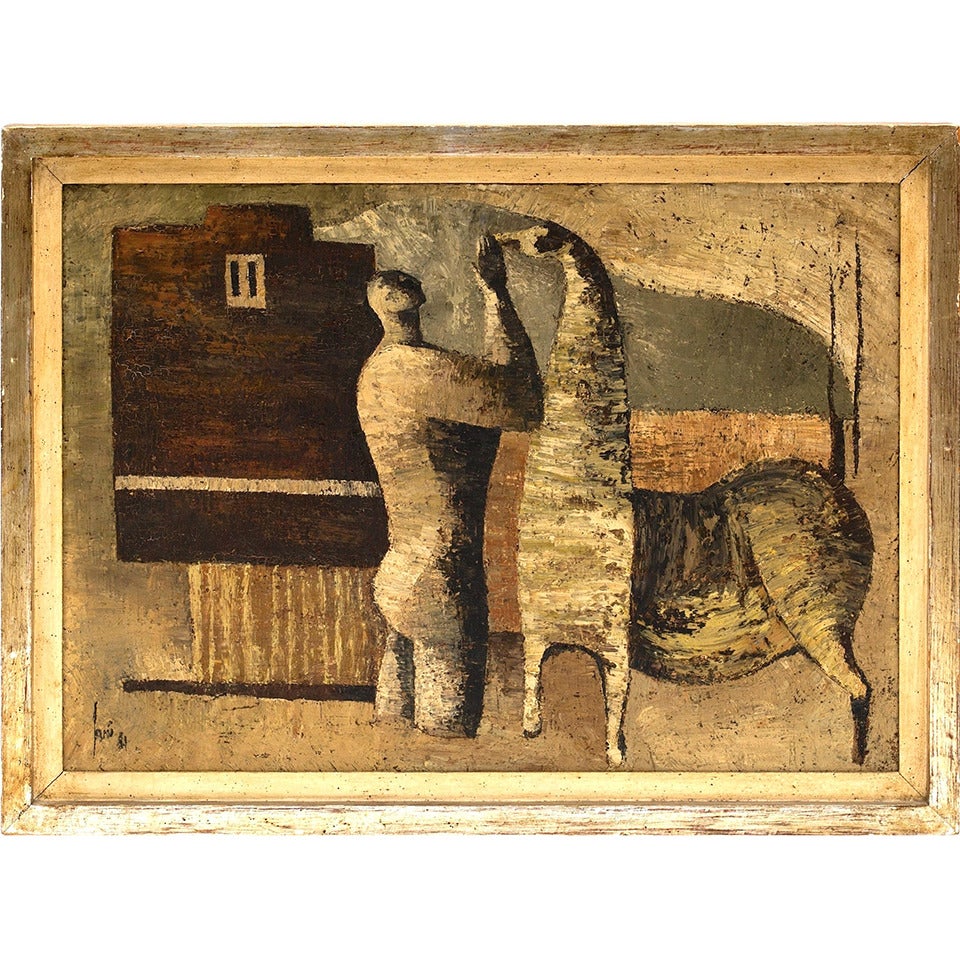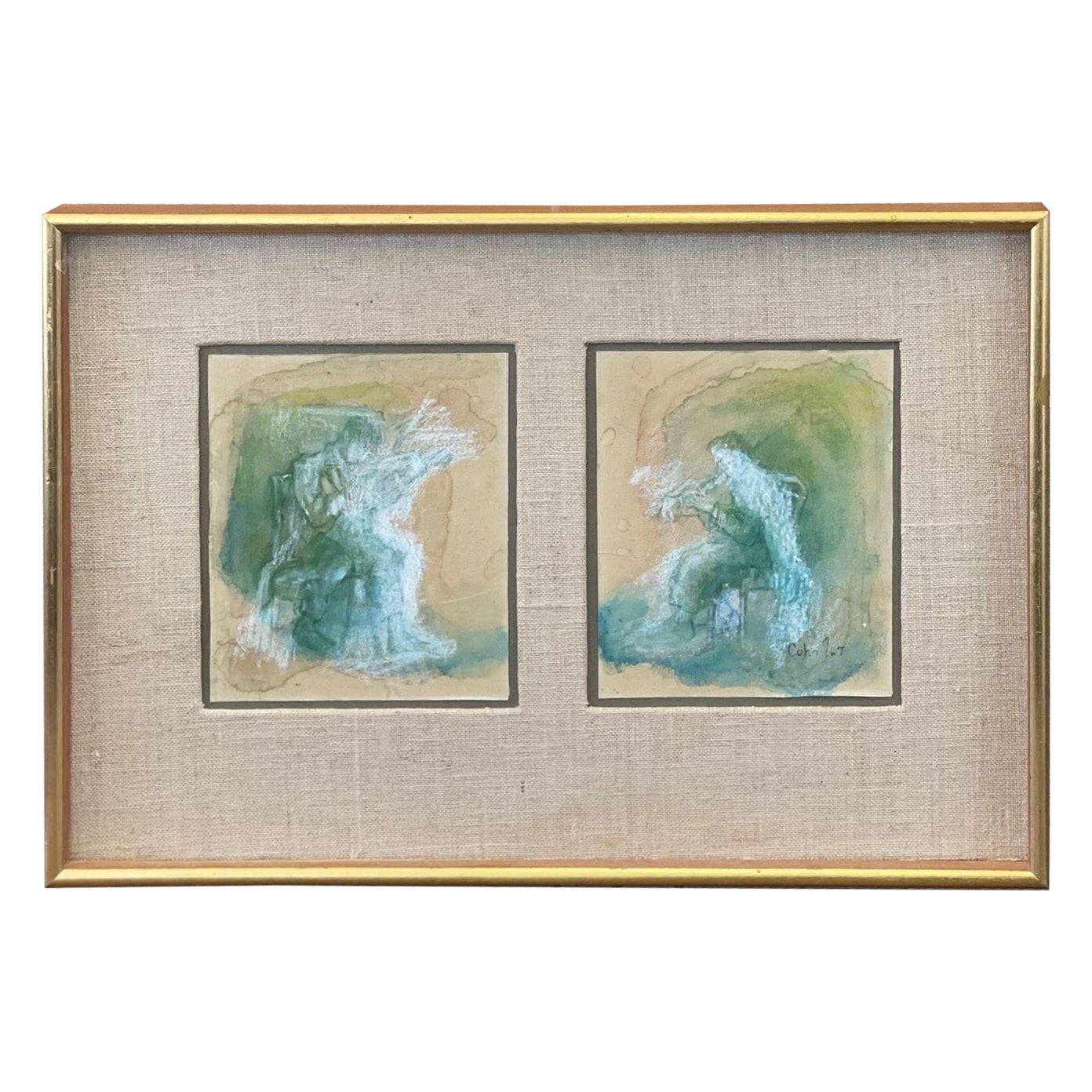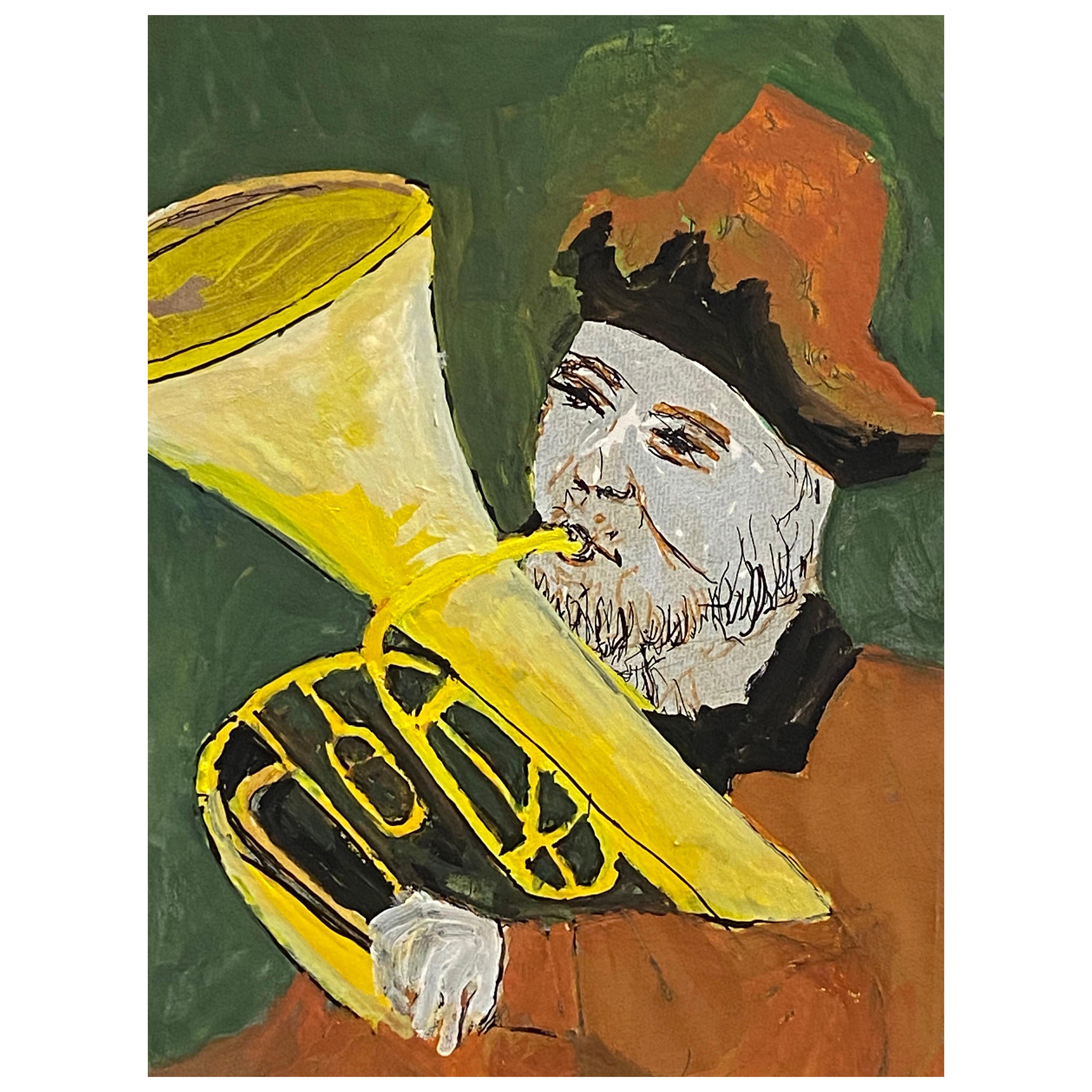Items Similar to Mixed Medium and Chalk Painting, Little Man Series
Want more images or videos?
Request additional images or videos from the seller
1 of 6
Mixed Medium and Chalk Painting, Little Man Series
About the Item
Part of the Little Man Series by Steven Colucci - Mixed media / Acrylic and chalk.
Steven Colucci was born to an Italian family in the South Bronx, near Yankee Stadium. His father owned and operated the dry cleaning service used by New York Giants. Colucci remembers sharing dinners with legendary athletes like Tucker Frederickson, Rosey Grier, Jim Brown and Frank Gifford. At 12 years old, he was diagnosed with severe dyslexia and forced to enroll at New York University Reading Institute, a small-private school in the East Village. During his years at NYU Reading Institute, he was encouraged to express himself through painting; he became particularly in representing movements through paint and carefully studied the works of John Marin, Jackson Pollock and Willem de Kooning.
After finishing the program at NYU Reading Institute, Colucci returned to William Taft high school in the Bronx, and remained focused on painting and won a scholarship to the School of Visual Arts. After graduating with the B.A. in painting, he moved to Paris to continue his studies in art and movement. It was in Paris that he began to study pantomime and ballet under the tutelage of world-famous movement artist Etienne Decroux. Decroux worked with him honing his talent, until he was discovered by Marcel Marceau in the late 70s. Marceau had few protégés, and Colucci quickly became one of them. For the next decade under Marceau’s instruction, he developed his own artistic voice and style.
In the 1980s, he moved back to New York where he developed a dance and mime program, which offered one-on-one workshops with the world-renowned dancers and musicians like Martin VanHamel, Kevin McKenzie, Dennis Koster, Gerald Busby and more. He brought his workshop to numerous colleges across the United States including Bard College, nationally recognized for its prestigious arts program and the Philadelphia Art Museum. Ronal Wilford, President of Columbia Artists Management, recognized Colucci’s work as high art.
Between 1980s and 1990s he was asked to collaborate with various dancers and artists including Alvin Ailey, Melba Moore, Royal Ballet of Flanders, Julio Iglesias ad Etienne Decroux to name a few.
By the late 1990s Colucci refocused on painting once again and retreated to his studio in Westhampton, L.I. His artwork has been exhibited at National Arts Club in Gramercy Park, the Grant Gallery and the Belenky Gallery in SoHo. His work is part of the permanent collection of the Mark Hachem Gallery in New York and Paris. The artist is a recipient of the prestigious Sam Flax memorial Award and the Orestes S. Lapolla Memorial Award from The School Art League of New York City and has been featured as a guest artist at the Museum of Modern Art.
Steven Colucci’s paintings and Haut Couture exhibition at the Mark Hachem Gallery, Madison Avenue, New York marked him debut as an haute couture designer. He feels fashion is a rendezvous of all the art forms making it a natural step for his career.
- Similar to:(after) Jackson Pollock (Artist)
- Dimensions:Height: 72 in (182.88 cm)Width: 48 in (121.92 cm)Depth: 0.5 in (1.27 cm)
- Materials and Techniques:
- Period:
- Date of Manufacture:2017
- Production Type:New & Custom(One of a Kind)
- Estimated Production Time:Available Now
- Condition:
- Seller Location:New York City, NY
- Reference Number:1stDibs: LU5191129125692
Farrago Design Inc
Farrago Design is a tribute to craftsmanship and creativity. Our story begins in 2003 with a passion for creating timeless bespoke pieces inspired by nature and the artistry of human hands. Our designs reflect a profound reverence for heritage and a commitment to excellence.
At Farrago Design, we believe that true opulence is achieved by an uncompromising attention to detail, a devotion to the craft, and the use of the finest materials. Our team of skilled artisans and designers collaborate with the world's most talented craftsmen to produce unparalleled, exclusive pieces. Our materials are carefully and sustainably sourced and include rare woods, sand casted metals, bone, and semi-precious stones, resulting in truly unique works of art. Our custom furniture designs are tailored to meet the specific needs of our clients, including some of the most prominent AD 100 interior designers and architects. We believe that every object in your home, office, or yacht should evoke a sense of joy and it is our privilege to share this vision with you.
About the Seller
No Reviews Yet
Vetted Seller
These experienced sellers undergo a comprehensive evaluation by our team of in-house experts.
Established in 2003
1stDibs seller since 2020
8 sales on 1stDibs
- ShippingRetrieving quote...Ships From: Westhampton Beach, NY
- Return PolicyA return for this item may be initiated within 14 days of delivery.
More From This SellerView All
- Mixed Media Painting by Steven Colucci, Sea SeriesBy Jackson PollockLocated in New York City, NYSteven Colucci’s iconoclastic approach to performance and the visual arts have not only long blurred the boundaries between these disciplines, but have challenged its most basic assumptions. The title of this show references a most rudimentary dance move -- the plié -- and our assumptions of what to expect in relation to this. Also the suggestion that we can simply press a button and a preconceived outcome will be courteously delivered -- a form of prefabricated belief in itself. Steven Colucci’s artwork turns such basic assumptions on their heads. Finding early inspiration in the New York school of abstract expressionists such as Jackson Pollock with his action painting, and then further by his professor -- a then young Vito Acconci while studying at the School of Visual Arts, Steven Colucci went from exploring the raw existentialist experimentation of New York’s early painting and performance scenes, to investigating the other end of the spectrum -- the rigorously measured and controlled disciplines of pantomime and ballet; studying in Paris under the tutelage of world-famous Marcelle Marceau, and engaging with the concepts of dramatic movement pioneer and intellectual Etienne Decroux. Colucci has explained the difference between the extremes of pantomime and dance as being that pantomime forces movement via an internal capacity -- movement directed inward to the core of one’s self -- a source requiring extreme mental and physical control. Dance by contrast is an external expression; likewise requiring great precision, although instead an extension of self or sentiment that projects outwardly. While such historical ‘movement’ disciplines serve as foundation blocks for Steven’s artistic explorations, it is the realm in between that he is best known for his contributions -- an experimental movement and performance art that simultaneously honors, yet defiantly refutes tradition; rejecting a compartmentalization regarding art and movement, yet incorporating its elements into his own brand of experimental pastiche. Colucci’s performance works manifest as eerily candy-coated and familiar, yet incorporate unexpected jags of the uncanny throughout, exploiting a sort of coulrophobia in the viewer; an exploration of a cumulative artifice that binds human nature against its darker tendencies; highlighting traditions of artifice itself -- the fabricated systemologies that necessitate compartmentalization in the first place. It is evident in Steven Colucci’s paintings that he has established a uniquely distinctive pictorial vocabulary; a strong allusion to -- or moreso an extension of -- his performance works. Colucci’s paintings depict a sort of kinetic spectrum, or as he refers to them “a technical expression of physicality and movement”. Whereas the French performance and visual artist Yves Klein used the human body as a “paint brush” to demarcate his paintings and thereby signify a residue of performance, Colucci’s utilization of nonsensical numbers and number sequences taken from dance scores, as well as heat-induced image abstraction depicting traces of movement likewise inform his vocabulary. In the strand of the choreographed, yet incorporating moments of chance, Colucci’s paintings represent an over arching structure; a rhythm of being and state, yet detail erratic moments -- moments that denote a certain frailty -- the edge of human stamina. Colucci’s paintings dually represent a form of gestural abstraction -- and also the reverse of this -- a unique anthropomorphization of varying states of movement -- that sometimes present as a temperature induced color field, at others are juxtapositions of movement and depictions of physical gestural images themselves. Colucci’s use of vernacular and found materials such as cardboard evoke his mastery of set design, and also reference a sort of collective experience of urbanity and the ephemeral. Such contradictions seem to permeate not only Steven Colucci’s artwork, but also are reflected in his person -- one who grew up in New York’s Bronx during a zeitgeist moment in visual and performing arts in the 1960s -- one who shifts with ease from happenings and experiments in New York City, to his meticulously choreographed megaproductions at Lincoln Center or starring in the Paris ballet...Category
2010s Paintings
MaterialsAcrylic
- Mixed Media Painting by Steven ColucciBy John ByardLocated in New York City, NYSteven Colucci’s iconoclastic approach to performance and the visual arts have not only long blurred the boundaries between these disciplines, but have challenged its most basic assumptions. The title of this show references a most rudimentary dance move --the plié --and our assumptions of what to expect in relation to this. Also the suggestion that we can simply press a button and a preconceived outcome will be courteously delivered --a form of prefabricated belief in itself. Steven Colucci’s artwork turns such basic assumptions on their heads. Finding early inspiration in the New York school of abstract expressionists such as Jackson Pollock with his action painting, and then further by his professor --a then young Vito Acconci while studying at the School of Visual Arts, Steven Colucci went from exploring the raw existentialist experimentation of New York’s early painting and performance scenes, to investigating the other end of the spectrum --the rigorously measured and controlled disciplines of pantomime and ballet; studying in Paris under the tutelage of world-famous Marcelle Marceau, and engaging with the concepts of dramatic movement pioneer and intellectual Etienne Decroux. Colucci has explained the difference between the extremes of pantomime and dance as being that pantomime forces movement via an internal capacity --movement directed inward to the core of one’s self --a source requiring extreme mental and physical control. Dance by contrast is an external expression; likewise requiring great precision, although instead an extension of self or sentiment that projects outwardly. While such historical ‘movement’ disciplines serve as foundation blocks for Steven’s artistic explorations, it is the realm in between that he is best known for his contributions --an experimental movement and performance art that simultaneously honors, yet defiantly refutes tradition; rejecting a compartmentalization regarding art and movement, yet incorporating its elements into his own brand of experimental pastiche. Colucci’s performance works manifest as eerily candy-coated and familiar, yet incorporate unexpected jags of the uncanny throughout, exploiting a sort of coulrophobia in the viewer; an exploration of a cumulative artifice that binds human nature against its darker tendencies; highlighting traditions of artifice itself - the fabricated systemologies that necessitate compartmentalization in the first place. It is evident in Steven Colucci’s paintings that he has established a uniquely distinctive pictorial vocabulary; a strong allusion to --or moreso an extension of --his performance works. Colucci’s paintings depict a sort of kinetic spectrum, or as he refers to them “a technical expression of physicality and movement”. Whereas the French performance and visual artist Yves Klein used the human body as a “paint brush” to demarcate his paintings and thereby signify a residue of performance, Colucci’s utilization of nonsensical numbers and number sequences taken from dance scores, as well as heat- induced image abstraction depicting traces of movement likewise inform his vocabulary. In the strand of the choreographed, yet incorporating moments of chance, Colucci’s paintings represent an over arching structure; a rhythm of being and state, yet detail erratic moments --moments that denote a certain frailty --the edge of human stamina. Colucci’s paintings dually represent a form of gestural abstraction --and also the reverse of this --a unique anthropomorphization of varying states of movement – that sometimes present as a temperature induced color field, at others are juxtapositions of movement and depictions of physical gestural images themselves. Colucci’s use of vernacular and found materials such as cardboard evoke his mastery of set design, and also reference a sort of collective experience of urbanity and the ephemeral. Such contradictions seem to permeate not only Steven Colucci’s artwork, but also are reflected in his person – one who grew up in New York’s Bronx during a zeitgeist moment in visual and performing arts in the 1960s – one who shifts with ease from happenings and experiments in New York City, to his meticulously choreographed megaproductions at Lincoln Center or starring in the Paris ballet...Category
2010s Paintings
MaterialsAcrylic
- Mixed Media Painting by Steven ColucciBy Jackson PollockLocated in New York City, NYSteven Colucci’s iconoclastic approach to performance and the visual arts have not only long blurred the boundaries between these disciplines, but have challenged its most basic assumptions. The title of this show references a most rudimentary dance move --the plié --and our assumptions of what to expect in relation to this. Also the suggestion that we can simply press a button and a preconceived outcome will be courteously delivered --a form of prefabricated belief in itself. Steven Colucci’s artwork turns such basic assumptions on their heads. Finding early inspiration in the New York school of abstract expressionists such as Jackson Pollock with his action painting, and then further by his professor --a then young Vito Acconci while studying at the School of Visual Arts, Steven Colucci went from exploring the raw existentialist experimentation of New York’s early painting and performance scenes, to investigating the other end of the spectrum --the rigorously measured and controlled disciplines of pantomime and ballet; studying in Paris under the tutelage of world-famous Marcelle Marceau, and engaging with the concepts of dramatic movement pioneer and intellectual Etienne Decroux. Colucci has explained the difference between the extremes of pantomime and dance as being that pantomime forces movement via an internal capacity --movement directed inward to the core of one’s self --a source requiring extreme mental and physical control. Dance by contrast is an external expression; likewise requiring great precision, although instead an extension of self or sentiment that projects outwardly. While such historical ‘movement’ disciplines serve as foundation blocks for Steven’s artistic explorations, it is the realm in between that he is best known for his contributions --an experimental movement and performance art that simultaneously honors, yet defiantly refutes tradition; rejecting a compartmentalization regarding art and movement, yet incorporating its elements into his own brand of experimental pastiche. Colucci’s performance works manifest as eerily candy-coated and familiar, yet incorporate unexpected jags of the uncanny throughout, exploiting a sort of coulrophobia in the viewer; an exploration of a cumulative artifice that binds human nature against its darker tendencies; highlighting traditions of artifice itself - the fabricated systemologies that necessitate compartmentalization in the first place. It is evident in Steven Colucci’s paintings that he has established a uniquely distinctive pictorial vocabulary; a strong allusion to --or moreso an extension of --his performance works. Colucci’s paintings depict a sort of kinetic spectrum, or as he refers to them “a technical expression of physicality and movement”. Whereas the French performance and visual artist Yves Klein used the human body as a “paint brush” to demarcate his paintings and thereby signify a residue of performance, Colucci’s utilization of nonsensical numbers and number sequences taken from dance scores, as well as heat- induced image abstraction depicting traces of movement likewise inform his vocabulary. In the strand of the choreographed, yet incorporating moments of chance, Colucci’s paintings represent an over arching structure; a rhythm of being and state, yet detail erratic moments --moments that denote a certain frailty --the edge of human stamina. Colucci’s paintings dually represent a form of gestural abstraction --and also the reverse of this --a unique anthropomorphization of varying states of movement – that sometimes present as a temperature induced color field, at others are juxtapositions of movement and depictions of physical gestural images themselves. Colucci’s use of vernacular and found materials such as cardboard evoke his mastery of set design, and also reference a sort of collective experience of urbanity and the ephemeral. Such contradictions seem to permeate not only Steven Colucci’s artwork, but also are reflected in his person – one who grew up in New York’s Bronx during a zeitgeist moment in visual and performing arts in the 1960s – one who shifts with ease from happenings and experiments in New York City, to his meticulously choreographed megaproductions at Lincoln Center or starring in the Paris ballet...Category
2010s Paintings
MaterialsAcrylic
- Mixed Media Painting by Steven Colucci- Two MenBy Jeff KoonsLocated in New York City, NYSteven Colucci’s iconoclastic approach to performance and the visual arts have not only long blurred the boundaries between these disciplines, but have challenged its most basic assumptions. The title of this show references a most rudimentary dance move --the plié --and our assumptions of what to expect in relation to this. Also the suggestion that we can simply press a button and a preconceived outcome will be courteously delivered --a form of prefabricated belief in itself. Steven Colucci’s artwork turns such basic assumptions on their heads. Finding early inspiration in the New York school of abstract expressionists such as Jackson Pollock with his action painting, and then further by his professor --a then young Vito Acconci while studying at the School of Visual Arts, Steven Colucci went from exploring the raw existentialist experimentation of New York’s early painting and performance scenes, to investigating the other end of the spectrum --the rigorously measured and controlled disciplines of pantomime and ballet; studying in Paris under the tutelage of world-famous Marcelle Marceau, and engaging with the concepts of dramatic movement pioneer and intellectual Etienne Decroux. Colucci has explained the difference between the extremes of pantomime and dance as being that pantomime forces movement via an internal capacity --movement directed inward to the core of one’s self --a source requiring extreme mental and physical control. Dance by contrast is an external expression; likewise requiring great precision, although instead an extension of self or sentiment that projects outwardly. While such historical ‘movement’ disciplines serve as foundation blocks for Steven’s artistic explorations, it is the realm in between that he is best known for his contributions --an experimental movement and performance art that simultaneously honors, yet defiantly refutes tradition; rejecting a compartmentalization regarding art and movement, yet incorporating its elements into his own brand of experimental pastiche. Colucci’s performance works manifest as eerily candy-coated and familiar, yet incorporate unexpected jags of the uncanny throughout, exploiting a sort of coulrophobia in the viewer; an exploration of a cumulative artifice that binds human nature against its darker tendencies; highlighting traditions of artifice itself - the fabricated systemologies that necessitate compartmentalization in the first place. It is evident in Steven Colucci’s paintings that he has established a uniquely distinctive pictorial vocabulary; a strong allusion to --or moreso an extension of --his performance works. Colucci’s paintings depict a sort of kinetic spectrum, or as he refers to them “a technical expression of physicality and movement”. Whereas the French performance and visual artist Yves Klein used the human body as a “paint brush” to demarcate his paintings and thereby signify a residue of performance, Colucci’s utilization of nonsensical numbers and number sequences taken from dance scores, as well as heat- induced image abstraction depicting traces of movement likewise inform his vocabulary. In the strand of the choreographed, yet incorporating moments of chance, Colucci’s paintings represent an over arching structure; a rhythm of being and state, yet detail erratic moments --moments that denote a certain frailty --the edge of human stamina. Colucci’s paintings dually represent a form of gestural abstraction --and also the reverse of this --a unique anthropomorphization of varying states of movement – that sometimes present as a temperature induced color field, at others are juxtapositions of movement and depictions of physical gestural images themselves. Colucci’s use of vernacular and found materials such as cardboard evoke his mastery of set design, and also reference a sort of collective experience of urbanity and the ephemeral. Such contradictions seem to permeate not only Steven Colucci’s artwork, but also are reflected in his person – one who grew up in New York’s Bronx during a zeitgeist moment in visual and performing arts in the 1960s – one who shifts with ease from happenings and experiments in New York City, to his meticulously choreographed megaproductions at Lincoln Center or starring in the Paris ballet...Category
2010s Paintings
MaterialsAcrylic
- My eyes on you -Mixed Media Painting by Steven ColucciBy Jackson PollockLocated in New York City, NYSteven Colucci is a perfectionist. As a painter, he describes himself as “a dictator, a controlling ballet master with a stick,” dispassionately choreographing his composition to achieve the exact result he desires. The paintings of the “Sea Series,” largely completed in 2010, are actually the culmination of 4-5 years of practice for the artist, during which he consistently developed and refined the language and formal elements that visually distinguish the series, sometimes repeating the same image for months until he was satisfied. Colucci’s methods and philosophy reflect his experience with movement as a performing art. While he studied with and admires Vito Acconci, Colucci is no proponent of conceptualism, finding his voice in the intense discipline of traditional forms, explaining, “If you don’t practice art like a classical pianist, every day, you can’t execute your concepts.” After completing his studies at New York’s School of Visual Arts, he moved to Paris, where he studied and performed mime and ballet, working closely with Marcel Marceau, who also painted, and Etienne Decroux, a sculptor as well as the originator of the form “classical mime,” which has roots in the sculpture of Rodin. If the word “sea” in the title of a painting conjures for you images of little easels and landscape canvases featuring sandy beaches, waves, and vast horizons, think again – Colucci’s oceanic visions are experiential, viewing them you are often looking down at the sea, within it, or even dreaming of the ocean. Water, deep or shallow, still or fast-moving, rules how we see light and subjects, as the artist works to reflect what he calls “the spirit, the soul of the water.” In “Deep Blue,” he conjures this anima via a window through levels of roiling currents of rich dark waves and dancing highlights, inviting the viewer to experience the sea as a vibrant and enveloping sensual entity. Colors, too, differ from the subdued palette of the seaside afternoon painter. Often his choices originate in what Colucci describes as the rhythm of color present in Afro-Carribean art and design. In the paintings, these hues express the water’s likeness to the seamless flow of the Dominican culture’s music and dance, which he so enjoys during frequent visits to Upper Manhattan’s El Barrio district, a movement with the melodic line that he so simply and perfectly employs in the delightfully sexy “Swimming with the Fish.” As our bodies, like the sea, are largely water, Colucci’s water visions...Category
2010s Paintings
MaterialsAcrylic
- Mixed Media Painting by Steven Colucci- My eyes on youBy Andrzej GalekLocated in New York City, NYSteven Colucci’s iconoclastic approach to performance and the visual arts have not only long blurred the boundaries between these disciplines, but have challenged its most basic assumptions. The title of this show references a most rudimentary dance move --the plié --and our assumptions of what to expect in relation to this. Also the suggestion that we can simply press a button and a preconceived outcome will be courteously delivered --a form of prefabricated belief in itself. Steven Colucci’s artwork turns such basic assumptions on their heads. Finding early inspiration in the New York school of abstract expressionists such as Jackson Pollock with his action painting, and then further by his professor --a then young Vito Acconci while studying at the School of Visual Arts, Steven Colucci went from exploring the raw existentialist experimentation of New York’s early painting and performance scenes, to investigating the other end of the spectrum --the rigorously measured and controlled disciplines of pantomime and ballet; studying in Paris under the tutelage of world-famous Marcelle Marceau, and engaging with the concepts of dramatic movement pioneer and intellectual Etienne Decroux. Colucci has explained the difference between the extremes of pantomime and dance as being that pantomime forces movement via an internal capacity --movement directed inward to the core of one’s self --a source requiring extreme mental and physical control. Dance by contrast is an external expression; likewise requiring great precision, although instead an extension of self or sentiment that projects outwardly. While such historical ‘movement’ disciplines serve as foundation blocks for Steven’s artistic explorations, it is the realm in between that he is best known for his contributions --an experimental movement and performance art that simultaneously honors, yet defiantly refutes tradition; rejecting a compartmentalization regarding art and movement, yet incorporating its elements into his own brand of experimental pastiche. Colucci’s performance works manifest as eerily candy-coated and familiar, yet incorporate unexpected jags of the uncanny throughout, exploiting a sort of coulrophobia in the viewer; an exploration of a cumulative artifice that binds human nature against its darker tendencies; highlighting traditions of artifice itself - the fabricated systemologies that necessitate compartmentalization in the first place. It is evident in Steven Colucci’s paintings that he has established a uniquely distinctive pictorial vocabulary; a strong allusion to --or moreso an extension of --his performance works. Colucci’s paintings depict a sort of kinetic spectrum, or as he refers to them “a technical expression of physicality and movement”. Whereas the French performance and visual artist Yves Klein used the human body as a “paint brush” to demarcate his paintings and thereby signify a residue of performance, Colucci’s utilization of nonsensical numbers and number sequences taken from dance scores, as well as heat- induced image abstraction depicting traces of movement likewise inform his vocabulary. In the strand of the choreographed, yet incorporating moments of chance, Colucci’s paintings represent an over arching structure; a rhythm of being and state, yet detail erratic moments --moments that denote a certain frailty --the edge of human stamina. Colucci’s paintings dually represent a form of gestural abstraction --and also the reverse of this --a unique anthropomorphization of varying states of movement – that sometimes present as a temperature induced color field, at others are juxtapositions of movement and depictions of physical gestural images themselves. Colucci’s use of vernacular and found materials such as cardboard evoke his mastery of set design, and also reference a sort of collective experience of urbanity and the ephemeral. Such contradictions seem to permeate not only Steven Colucci’s artwork, but also are reflected in his person – one who grew up in New York’s Bronx during a zeitgeist moment in visual and performing arts in the 1960s – one who shifts with ease from happenings and experiments in New York City, to his meticulously choreographed megaproductions at Lincoln Center or starring in the Paris ballet...Category
2010s Paintings
MaterialsAcrylic
You May Also Like
- Oil Painting of a Little BoyLocated in Culver City, CAOil on linen in period frame. Signed Fertcez.Category
Antique Late 19th Century European Paintings
MaterialsPaint
- Vintage Abstract Expressionist Oil Paintings on MasoniteBy (after) Jackson PollockLocated in New York, NYSeries of 5 abstract expressionist painting each on a Masonite board. These paintings were purchased from an estate in Westchester NY, they date from the 1960s or 1970s they are well...Category
Mid-20th Century American Expressionist Paintings
MaterialsMasonite
- Traditional English Painting Chalk Church from Fulborough Marshes in KentBy English SchoolLocated in Cirencester, GBArtist/ School: Norman A. Olley ( British, 20th Century, 1908-1996), c.1990, signed to the front and inscribed verso Title - Chalk Church from Fulborough Marshes near Gravesend, K...Category
Late 20th Century English Paintings
MaterialsOther
- Sergio Sarri Abstract Man & Horse PaintingBy Sergio SarriLocated in New York, NYFabulous early painting by listed Italian artist Sergio Sarri, Man and Horse, circa 1961 found in its original gilt silver and gold burnish wood frame. St...Category
Vintage 1960s Italian Paintings
MaterialsCanvas
- “Musician Series “ Painting by Lorraine CohnLocated in Seattle, WA“Musician Series “ Painting by Lorraine Cohn Dimensions. 16 W ; 1 1/2 D ; 11 H.Category
Vintage 1970s Mid-Century Modern Paintings
MaterialsWood
- 1960's British Original Oil Painting, Wise Man PortraitLocated in Cirencester, GBArtist: Beryl Darton (British circa 1960's) Period: mid 20th century/ 1960's Medium: oil painting on board, unframed Size: 20 x 16 inches Condition: overall very good, a ...Category
Mid-20th Century Paintings
MaterialsOther
